We were up and at ’em Wednesday morning – in the lobby by 07:00, on the bus at 07:10, and at the Darwin Convention Centre for check-in and a light breakfast┬Ā prior to boarding The Ghan for our scheduled trip to Alice Springs. This was to be the second overnight train trip in the RS package and the procedure was quite reminiscent of what we’d done in Perth (if a bit more cumbersome) prior to boarding the IP. In addition to the light breakfast, we had live entertainment in the person of David Spry – a local Aboriginal musician who played mainly pop covers that morning. He and I had a nice chat and he kindly gave me a CD of his music.
Once on board, one of my first tasks was to have one of my fellow Road Scholars take this photo of me.

It’s meant to evoke this photo

taken on my other extended train trip some 11 years prior that took me from Beijing to Saint Petersburg.
It’s easy to make sense of the name of the IP since it describes the journey the train makes from the Indian Ocean on Australia’s west coast to the Pacific Ocean on its east. Running from Darwin in the north to Adelaide in the south the reason the train is called The Ghan isn’t quite as obvious. The first thing you need to know is that it had its name long before the extension to Darwin was completed in 2004.
Journey Beyond Rail Expeditions operates both the IP and the Ghan. (In fact, the crews will often shift between the two.) Their website provides the official explanation for the train’s name:
The Ghan train was named for the pioneering cameleers who blazed a permanent trail into the Red Centre of Australia more than 150 years ago; the original Ghan line following the route of explorer John MacDouall Stuart.
While some of those “pioneering cameleers” might have actually been from Afghanistan, many were from other locations such as British India, Turkey, or Egypt. White Australians referred to them all (probably derogatorily) as Afghans and these men were subjected to racist policies such as the Immigration Restriction Act of 1901 which made it difficult for them to remain in Australia or to return after visiting their families abroad and, of course, the other prejudices of the era. You can decide whether naming the train The Ghan or even using this as its logo
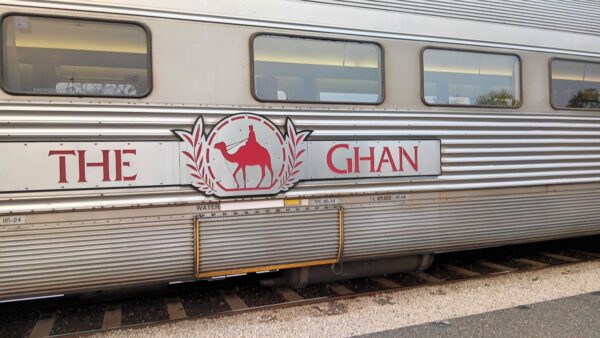
provides them with sufficient honor.
Before it was shortened to The Ghan, the train was called the Afghan Express. One popular account says railway workers first applied the nickname Afghan Express when the lone passenger on the train’s first return journey from Quorn to Oodnadatta with a newly added sleeping car was an Afghan man.
On to Nitmiluk
I acknowledge that I am on the land of the Jawoyn People. I acknowledge their custodianship. The Dreaming is still living. From the past, in the present, into the future. Forever. I would also like to pay respect to the Elders past, present, and emerging and extend that respect to other Aboriginal people present.
I didn’t note whether the train left Darwin at its appointed time of 09:30 but I didn’t note that it was significantly late either. However, Wednesday was at least every bit as hot as Tuesday had been and the excess heat (in the 40s again) slowed the train’s progress to its first scheduled stop at the town of Katherine and our scheduled off-train field trip to Nitmiluk (pronounced NIT-me-look) National Park and the famous gorges. We arrived an hour later than scheduled.
For those interested, the European name had its birth in 1862 when John McDouall Stuart crossed the river
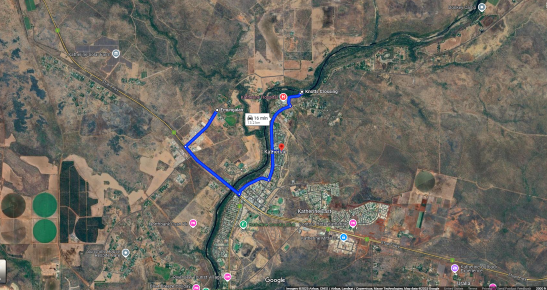
[From Google Maps]
and recorded in his diary that he named it “Katherine, in honour of the second daughter of James Chambers.” Chambers had financially sponsored his exploration expedition. European settlement began in 1871 with the establishment of the Katherine Telegraph Station as part of the Overland Telegraph Line at the site now called Knott’s Crossing. It moved to Emungalan in 1917 before settling in its present location in 1926 with the completion of the railway bridge.
Part of the rail package included a boat ride on the river through the famed gorges. Thus it was that we took the 20 minute bus (coach) ride to Nitmiluk Tours for a walk and boat ride through the river gorges.
What the geologists say
(Note: Nitmiluk means Cicada Place and is the place name the Jawoyn People received from Nabilil in the Creation time. However, in discussing the western view of the creation of the gorges, I will use Katherine River because it’s more widely represented on western maps.)
Travel in a northeasterly direction 150km from Katherine into the high sandstone escarpment country of Arnhem Land close to Kakadu NP and youŌĆÖll reach the headwaters of the Katherine River. As you might have learned from this post, rivers naturally seek a baseline elevation into which they can drain and they will carve through rock to do so.
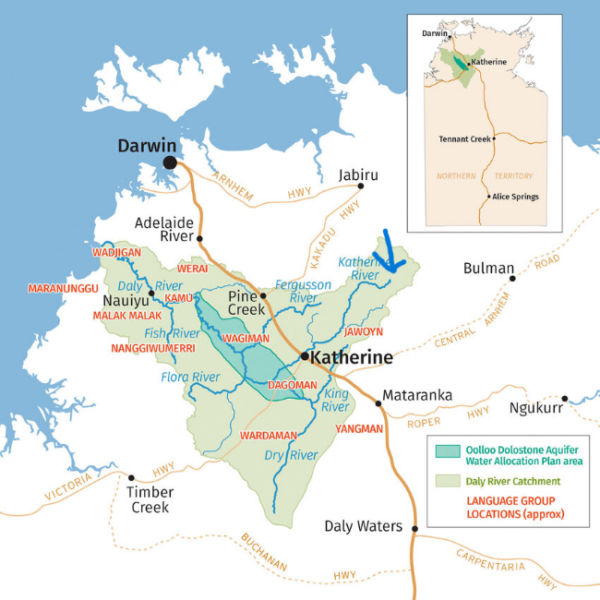
[From Research Gate – Map uploaded by Sue E Jackson]
The Katherine River began carving the gorges through which weŌĆÖll cruise by cutting downward through its bed in a process called vertical erosion thatŌĆÖs common in the upper course of rivers. Although the Kombolgie Formation sandstone is approximately 1,650,000,000 years old, itŌĆÖs no match for the erosive power of a river determined to reach its baseline level and the Katherine River has carved these gorges in a mere 25,000,000 years.
Our cruise will take us through two or three of the 13 ancient sandstone gorges that follow a zigzag path along intersecting joints in the rock formation. Some of the gorges (though not the one in the photo below) have cliffs rising as high as 100 meters.
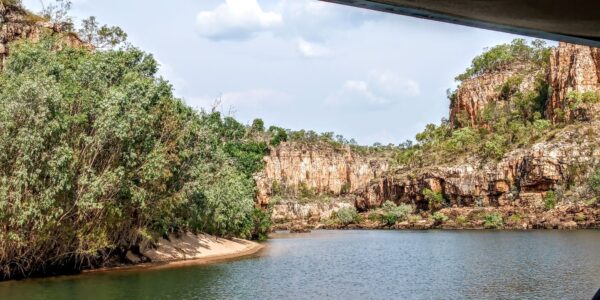
The Jawoyn Origin of Nitmiluk
(Sleeping fully formed)
Nabilil is a dragon-like figure who came from the west near Wadeye (Port Keats). He travelled carrying water and firesticks in a dilly bag under his arm passing through Garrakla (the limestone formations that abut the Stuart Highway). The country was very dry and as he passed through the Blue Tongue Lizard dreaming places at Yerreljlrriyn and Wun-gurri, all the birds tried to catch him to get the water he carried.
Nablil proved too clever for Lumbuk, the pigeon, Wakwak, the crow and Garrkayn, the brown hawk and he eventually reached the entrance to the gorge where he heard the song of the cicada, Nit! Nit! Nit! Nit! He called this place Nitmiluk.
Other places named in similar ways can be seen along the gorges. What is called the second gorge today
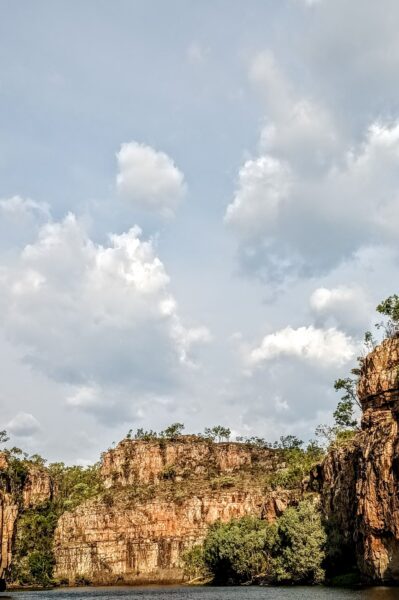
is the place where Barraya (the Kookaburra) emerged. Farther upstream Barrak Barrak (female and male diver ducks) collided with two cliffs at a notable spur on the river and` submerged on either side, leaving their name. Bemang, the Blanket Lizard came from Rembarrnga Country (about 125km south of Nitmiluk) giving his name to the series of hills along the road close to the Gorge. Bemang (then travelled up towards Pine Creek. At Wun-gurri, the divided river represents Gurri (the female blue tongue).
For the Jawoyn, most of these Dreaming places are not dangerous, but some may have to be approached with care or not disturbed at all.
Manifesting a Road Scholar Dreaming
A week or two before the beginning of our trip we received an introductory email from a RS representative in Australia. In Road Scholar’s published material, they name this trip, “The Great Australian Train Trek”. The subject line in this email read, “Road Scholar 3110-102624 Great Australian Train Wreck”. I certainly can’t say this typographical error had any actual influence on the message we received when we reboarded the train but there had, indeed been a train wreck although it didn’t involve The Ghan.┬Ā A freight train had derailed near Tennant Creek.
Look at the inset in the map above. You’ll see that Tennant Creek is between Katherine and Alice Springs. This effectively wrecked this segment of our rail journey. The train had turned around and would return us to Darwin where we’d spend the night on board.
What happened next could almost be considered miraculous (if you’re inclined to believe in that sort of thing) but you won’t learn that until my next post. Meanwhile, here are 30 or so photos from our boat ride that you haven’t yet seen.
You never mention it but that short but very hot climb over the rocks to change boats was not as difficult as you might think it would be in the one hand but the heat was a killer.
I probably didn’t mention it because the heat really didn’t bother me and I generally found myself moving more quickly than most of the group and was probably self-absorbed enough particularly because I wanted to avoid falling (e caio frequentemente) not to have noticed others might be struggling with the heat.
Could be. I remember there were a number of people that didnŌĆÖt even attempt the climb because of the inherent challenge in the climb and the heat. You are pretty heat impervious!
Could be. I remember there were a number of people that didnŌĆÖt even attempt the climb because of the inherent challenge in the climb and the heat. You are pretty heat impervious!
Glad to see you repping some Terps gear on your trips! Hard to believe those socks have lasted 11 yearsŌĆ”.?
If you think that’s impressive, I have to tell you about some of my sweatshirts. Serious, regarding the socks, I only wear them on special occasions.
Forgot to say that I looked at my notes on pictures from the day and it was 104 degrees in the gorge. Heat definitely does not bother you!!
That’s true. Cold is a different story. On all my travels, the heat only affected me once and that was more a result of the rapidity of the change and my clothes that were appropriate for my departure but not my arrival. I wrote about that here: https://gruncleodd.com/a-breath-of-hot-air/